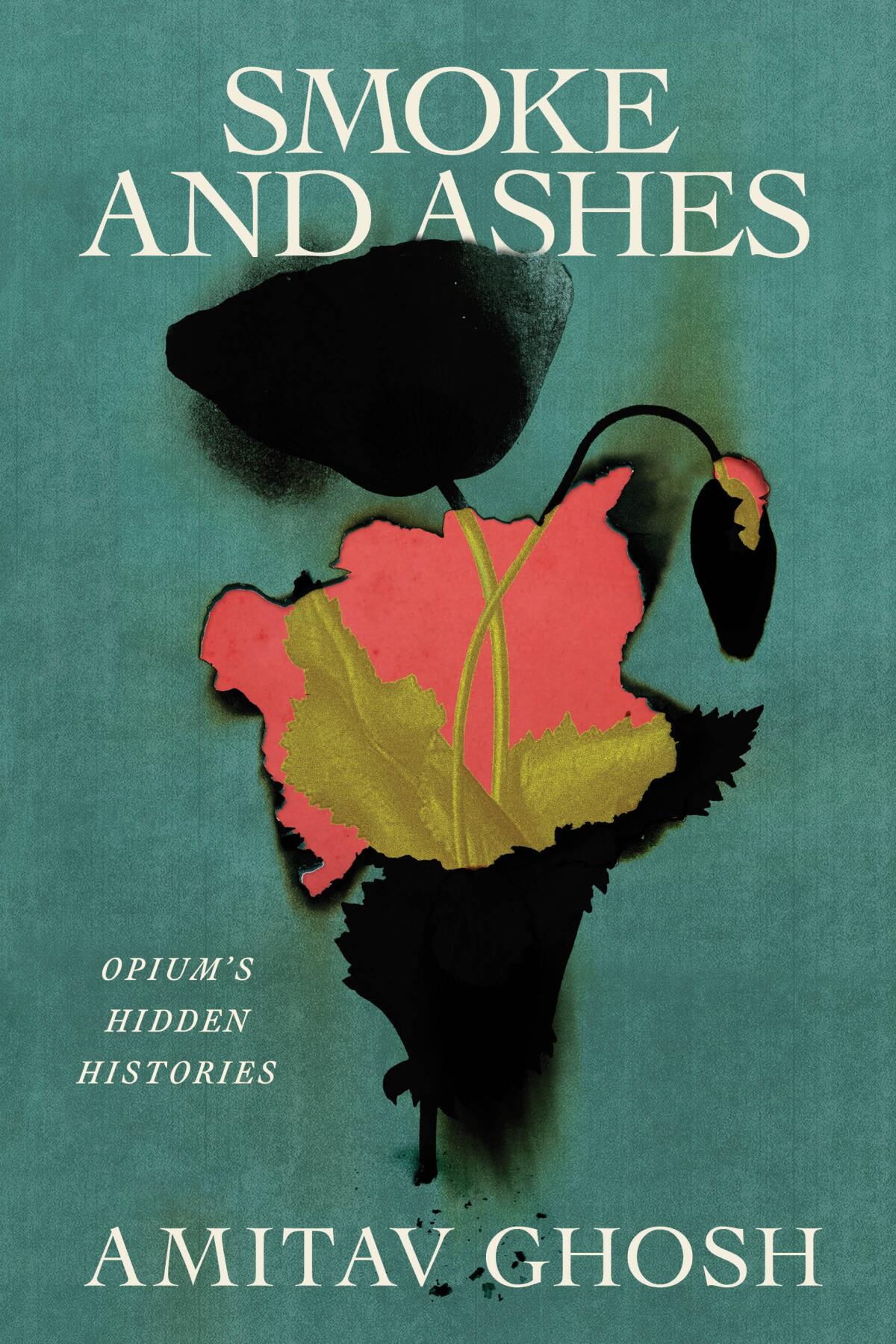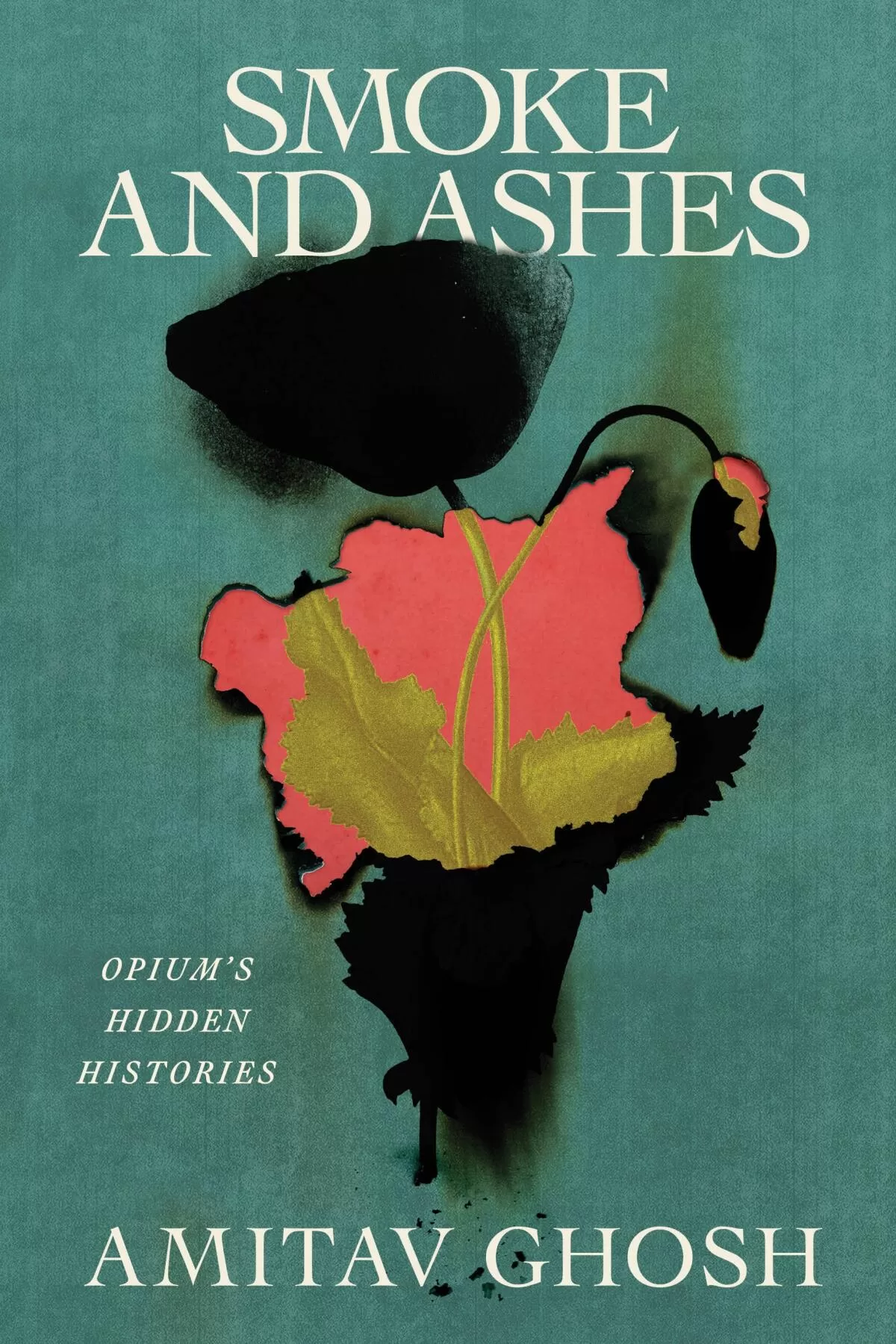On the Shelf
‘Smoke and Ashes: Opium’s Hidden Histories’
By Amitav Ghosh
Farrar, Straus and Giroux: 416 pages, $32
If you buy books linked on our site, The Times may earn a commission from Bookshop.org, whose fees support independent bookstores.
After the mid-18th century, when the British East India Co. was importing tea from China, few could have guessed that the industry would be revolutionized by a different plant: the opium poppy. Over the next century and beyond, Britain and other colonial powers, joined by American and Indian merchants, amassed unimaginable wealth by getting the Chinese addicted to opium. It was opium money from trade with China that primarily funded the expansion of so many Western corporations and institutions.
In his latest book, “Smoke and Ashes: Opium’s Hidden Histories,” Amitav Ghosh subverts Eurocentric history and digs open the recesses of racial capitalism, specifically Indian farmers coerced into growing poppy and the consequent pumping of opium into China. Ghosh exposes the hypocrisy of the Western world in perpetrating structural violence against Asians under the garb of free trade and progress and the uncanny similarities between the Machiavellian tactics of the opium business in China and of those who triggered the modern-day American opioid crisis. This conversation has been edited lightly.
China has long been perceived as an alien culture by the West. It has been demonized time and again, and after the COVID-19 outbreak, the animosity toward China has only worsened. But most Americans aren’t aware of the legacy in America of merchants who made their fortune in Guangzhou (Canton). Could you throw more light on that?
It might come as a shock to most readers that the U.S. has been dependent on China right from the very start. In 1783, when America was born, it was unable to trade with any of its neighbors that were still part of the British Empire. So, the Americans realized that it was essential for them to trade with China. In fact, one of the grievances that led to the birth of the U.S. was that the Americans were initially prohibited from trading with China because the trade was in the hands of the British East India Co. There was a lot of resentment against the East India Co.’s monopoly over tea. So almost immediately after the birth of the republic, China became the primary trading partner for the U.S. But the problem that the U.S. had in relation to China was the same that the British had — that the world again has today in relation to China — that the whole world buys Chinese goods, but the world doesn’t have any goods or enough goods to sell to China apart from resources because the Chinese make everything themselves. China was then, as it is now, the world’s great manufacturing hub.

(Farrar, Straus and Giroux)
So many of the technologies that we know today were stolen from China by the West, such as porcelain, gunpowder, compasses and bank deposit insurance. When the Americans started trading with China in the late 18th century, they started with furs and later sandalwood, but soon they just couldn’t find enough stuff to sell to China. So eventually they started doing what the British did: They started selling opium to China, sourced initially from Turkey and then later from India. For many generations, young Americans, especially very privileged white men predominantly from Massachusetts and other parts of New England and New York, would travel to China, and they would come back within four or five years with these immense fortunes. China gave them the experience of doing global trade, understanding currencies and foreign exchange, etc. They also became aware of the new industries that were then arising in Europe because of the Industrial Revolution. So, they came back to the U.S. and became the founders of all these modern industries, most importantly, perhaps the railroads.
You’ve drawn parallels between the Chinese opium crisis and the American opioid crisis. The British blamed the Chinese for being corrupt and mentally feeble. According to the British, they were simply meeting the Chinese demand for opium. Whereas we’ve seen in the American opioid crisis that it’s not demand but supply that dictates the flow of opium, as is evident in the case of the five states that had additional regulations to curb the prescription of opioids. These states (California, Idaho, New York, Texas and Illinois) experienced low growth in overdose deaths. So, it’s clear that it is supply and not demand that controls opium.
Initially, the British had trouble selling even 500 crates of opium to China, but once it got on, it was like a forest fire, and by the end of the 19th century, the Chinese were consuming hundreds of thousands of crates of Indian opium. So, when the anti-opium movement tried to constrain the British Empire from selling opium, the British deflected the blame onto the Chinese demand for it. This is essentially what the Sackler family also said in America when they introduced OxyContin; addicts were blamed. The British “logic”: There’s a demand for it, and if we don’t meet it, then someone else will.
The Sacklers were aided by a lot of historians and academicians who put forth revisionist arguments in favor of rehabilitating opioids. They even took the FDA into confidence, right?
That’s right. It wasn’t until the victims’ families began to protest in a very big way that the narrative changed. Until then, the people who were defending opiates had control of the narrative for the longest time. I think it’s also important to note that this kind of opioid crisis seems to go hand-in-hand with a certain kind of civilizational crisis. That was certainly the case with China when it started getting engulfed in the web of opium in the late 18th century. Suddenly, it found itself having to question its ideas of centrality in the world. It was facing, literally, an existential threat.
I think something very similar is happening in America today. There’s really a profound sense of civilizational crisis. And for ordinary Americans, they are facing life conditions that are unimaginably difficult. In a way, the opioid crisis took off because of all these other factors within society. Deindustrialization was happening, and old mining communities were disintegrating. Opium was sold to extremely vulnerable communities where there was a lot of pain and social difficulties. So, we really see a kind of playing out of what happened in China in the 19th century.
The anti-opium movement in the early 20th century rattled the British Empire, and eventually China succeeded in getting most of its population off opium. You’ve pointed out in your book that one of the problems with the American war on drugs was that it pinned the blame not only on the producers but also on the consumers, whereas the anti-opium drive only targeted the producers. The Chinese establishment ensured that they treated the addicts with sympathy.
This is the problem, really. The war on drugs was a state-led movement initiated by the U.S. armed forces and its security establishment. And there was a kind of double dealing involved because the Americans were using heroin, etc. in their conflicts in Southeast Asia, Latin America and so on. At the same time, they were also trying to suppress cocaine and other drugs, and they created an incredible mess. The first problem with the war on drugs is the idea of what exactly constitutes a drug. Many of the substances that they banned and considered drugs were, as we now know, in many ways beneficial to humanity.
Now they’ve changed strategies. More and more states are recognizing that many substances they call drugs are actually very beneficial, like psilocybin mushrooms, which can be used to treat depression. America now finds itself trying to control the circulation of heroin, fentanyl, etc. The problem is that again, it’s a state-led initiative, and it’s failing. Opioid-related deaths peaked during COVID-19, and it was thought that after the epidemic they would tail off. But no, it’s only continued to grow. Especially because fentanyl is so cheap and easily available, more and more people are dying of substance abuse.
What happened in Asia in the late 19th century and early 20th century was a very remarkable thing. You saw the emergence of a popular grassroots movement that was opposed to the free circulation of opioids, and that was effective. Even though, in China, the addiction problem continued until the 1950s, when, finally, the Communist Party did crack down on it. I don’t think any country will be able to reproduce that today.
One of the problems with addiction is that it happens indoors; the victims are out of sight. If you just look around America today, you wouldn’t think there was a problem. Many people who traveled to China in the 19th century thought everything was fine, but it wasn’t. In recent years, the U.S. Army has not been able to meet its recruitment goals. A recent survey found that not even 25% of young Americans are eligible to serve in the Army, partly because of obesity, mental health problems or drug use. Now that is a crisis.
